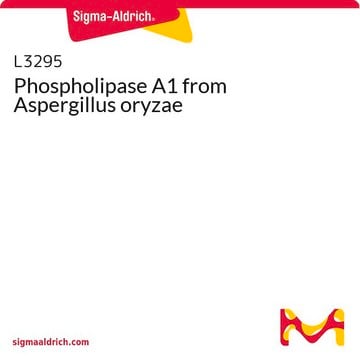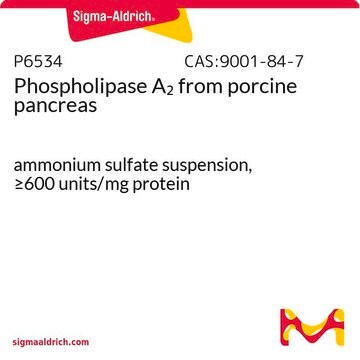P4912
Phospholipase D from Streptomyces sp.
Type VII, lyophilized powder, ≥150 units/mg solid
Synonyme(s) :
Lecithinase D, Phosphatidylcholine phosphatidohydrolase
Se connecterpour consulter vos tarifs contractuels et ceux de votre entreprise/organisme
About This Item
Produits recommandés
Source biologique
Streptomyces sp.
Niveau de qualité
Type
Type VII
Forme
lyophilized powder
Activité spécifique
≥150 units/mg solid
Température de stockage
−20°C
Application
Phospholipase D (PLD) has been used to hydrolyze the phosphate bonds of phospholipids and sphingomyelin to yield the corresponding phosphatidic acid. It has also been used to study metabolic labeling and direct imaging of choline phospholipids in vivo by measuring propargyl-Cho incorporation. Furthermore, PLD has been used in purification and kinetic studies.
The enzyme from Sigma has been used in the translocation of sphingosine kinase 1 (SK1) to membrane fractions under in vitro conditions. It has also been used to produce phosphatidic acid (PA) from phosphatidylcholine (PC) in HL60 permeabilized cells.
Actions biochimiques/physiologiques
Phospholipase D is glycerophospholipid-specific. It is markedly less active on sphingomyelins and lysophospholipids. Phospholipase D hydrolyzes the phosphate bonds of phospholipids and sphingomyelin to give the corresponding phosphatidic acid.
Hydrolyzes the phosphate bonds of phospholipids and sphingomyelin to give the corresponding phosphatidic acid.
Conditionnement
Bottomless glass bottle. Contents are inside inserted fused cone.
Définition de l'unité
One unit will liberate 1.0 μmole of choline from 1,2-Dioleoyl-sn-glycero-3-phosphocholine per hour at pH 8.0 at 37 °C.
Remarque sur l'analyse
Protein by biuret
Inhibiteur
Réf. du produit
Description
Tarif
Mention d'avertissement
Danger
Mentions de danger
Conseils de prudence
Classification des risques
Resp. Sens. 1
Code de la classe de stockage
11 - Combustible Solids
Classe de danger pour l'eau (WGK)
WGK 3
Équipement de protection individuelle
Eyeshields, Gloves, type N95 (US)
Certificats d'analyse (COA)
Recherchez un Certificats d'analyse (COA) en saisissant le numéro de lot du produit. Les numéros de lot figurent sur l'étiquette du produit après les mots "Lot" ou "Batch".
Déjà en possession de ce produit ?
Retrouvez la documentation relative aux produits que vous avez récemment achetés dans la Bibliothèque de documents.
Les clients ont également consulté
Fava beans can substitute soybean meal and rapeseed meal as protein source in diets for lactating dairy cows.
Hansen, et al.
Journal of Dairy Science, 104, 5508-5521 (2021)
Mohamed H Yaghmour et al.
Journal of lipid research, 62, 100022-100022 (2021-01-17)
Phospholipids with a choline head group are an abundant component of cellular membranes and are involved in many important biological functions. For studies on the cell biology and metabolism of these lipids, traceable analogues where propargylcholine replaces the choline head
Christine Delon et al.
The Journal of biological chemistry, 279(43), 44763-44774 (2004-08-18)
Sphingosine kinase 1 (SK1) phosphorylates sphingosine to generate sphingosine 1-phosphate (S1P). Because both substrate and product of the enzyme are potentially important signaling molecules, the regulation of SK1 is of considerable interest. We report that SK1, which is ordinarily a
Kathryn Garner et al.
The Journal of biological chemistry, 287(38), 32263-32276 (2012-07-24)
Phosphatidylinositol transfer proteins (PITPs) are versatile proteins required for signal transduction and membrane traffic. The best characterized mammalian PITPs are the Class I PITPs, PITPα (PITPNA) and PITPβ (PITPNB), which are single domain proteins with a hydrophobic cavity that binds
Milya Davlieva et al.
Antimicrobial agents and chemotherapy, 57(1), 289-296 (2012-11-02)
Daptomycin (DAP) resistance in enterococci has been linked to mutations in genes that alter the cell envelope stress response (CESR) (liaFSR) and changes in enzymes that directly affect phospholipid homeostasis, and these changes may alter membrane composition, such as that
Notre équipe de scientifiques dispose d'une expérience dans tous les secteurs de la recherche, notamment en sciences de la vie, science des matériaux, synthèse chimique, chromatographie, analyse et dans de nombreux autres domaines..
Contacter notre Service technique










